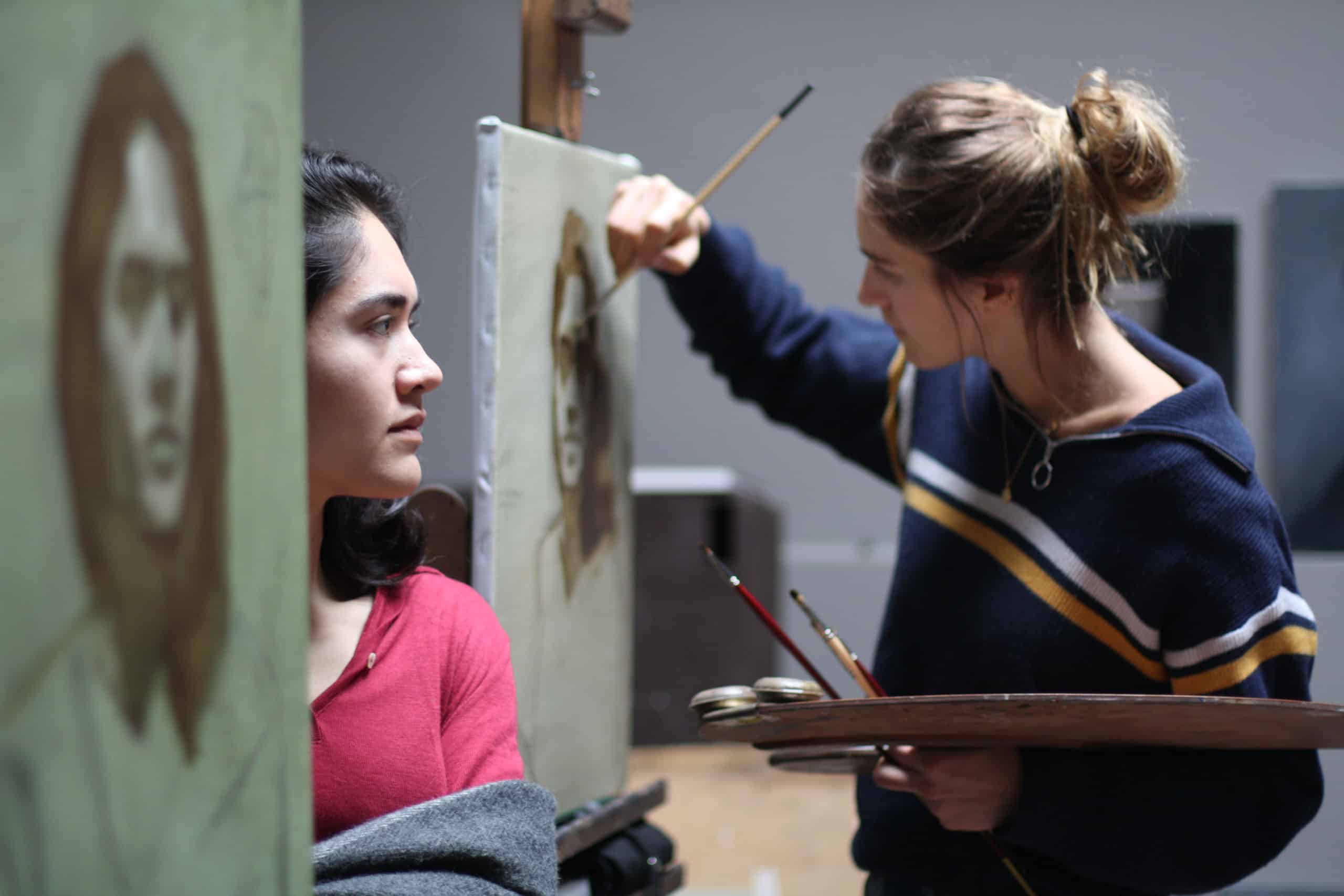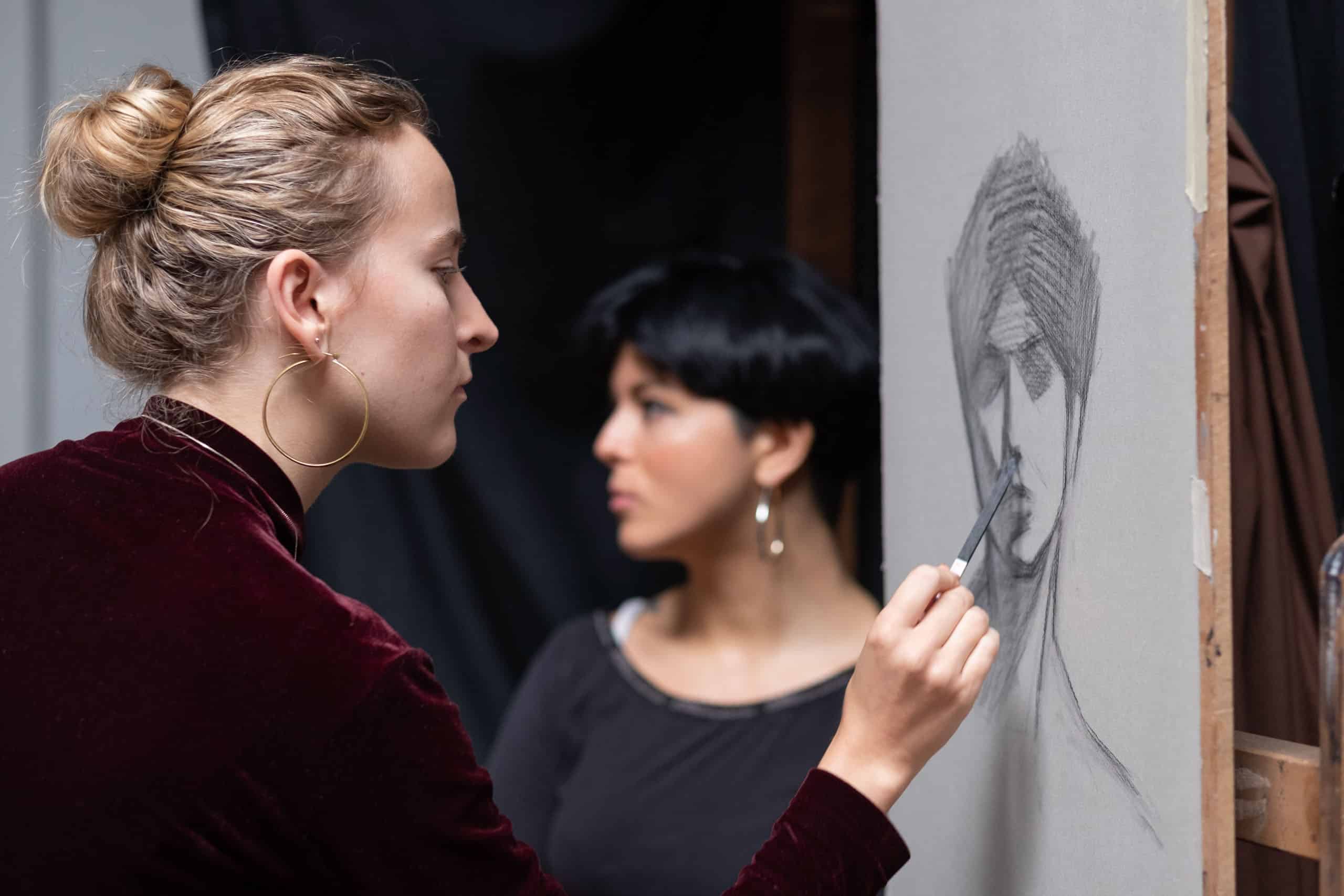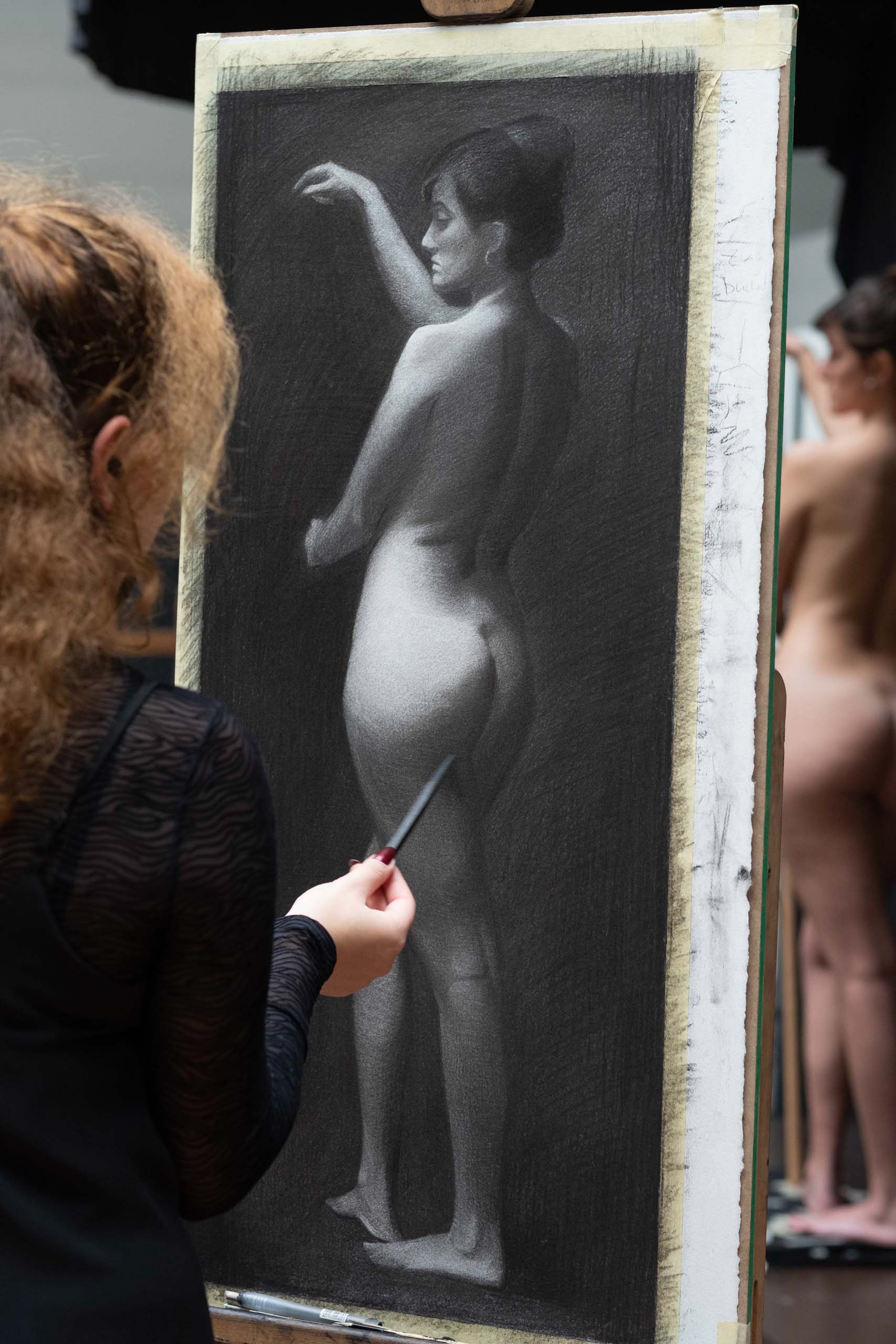General Description
Please note previously of 6 weeks duration, the updated 5-week course offers the exact same hours of training, class time, and number of projects as the 6-week schedule.
Providing a rich and fulfilling educational experience in Florence, the combination of intensive studio practice and guided museum visits will substantially enhance students’ skill level. This 5-week course will introduce the classical methods of training in the visual arts, enriching visual vocabulary and providing a methodology that can be applied to other art disciplines. Students discover the richness and beauty of Italian drawing and painting, and have the opportunity to discover how the masters created works of such universal significance. Work in the studio echoes our full-time program, and many of the exercises are the same and taught by experienced and expert faculty members.
This Intensive workshop offers five weeks of studio based training with the opportunity to add a second 5-week session to reach a higher level of skill and experience.
Delivered in two distinct 5-week parts, Parts I & II can be taken consecutively as a 10-week course, again to maximize learning outcomes. Part I provides an introduction to sight size and the academic drawing & painting method through projects such as copies from old master drawings, figure drawing, cast drawing, still life, and portrait painting. The 5-week Intensive Course – Part II increases the difficulty level of these projects; students produce cast and figure drawings using charcoal & white chalk, while they have longer to develop more complex still life and portrait paintings, and learn how to prepare their own materials and produce preliminary studies. The workshops can also be taken separately, and at separate times, however completion of Part I is a prerequisite for Part II.
Instruction is by individual critique and frequent class demonstrations.
Beginning – Intermediate – Advanced levels welcome.
Maximum enrollment 14 students.
A short distance from the historic city center in a quiet Italian neighborhood, students work from easels under natural north light, just like the old master painters of the past. Florence Academy faculty will guide them through the techniques of sharpening charcoal, blocking in the shadow shapes, and understanding how to translate three-dimensional forms into two dimensions. Instruction is designed to take students of all levels through a series of exercises aimed to develop their observational skills and accuracy in drawing and painting, whilst learning a methodology to translate and record directly from nature.
During the mornings, students immerse themselves in the study and practice of drawing; in the afternoons, they practice painting.
A brief introduction to copying from old master drawings to understand measurement, proportion and shadow shape, students progress to drawing from the plaster cast, and painting the still life, portrait and the figure. They will practice using charcoal, pencil and oil. The program is very similar to the one offered to full time students at The Florence Academy of Art.
Working from life is a unique and fulfilling experience, one that is fundamental to the training at the Florence Academy and central to a long-standing tradition. Working from a live model, students will learn how to approach the human figure, observing proportion, body type and gesture and important anatomical points. With pencil there will be a linear approach focusing on outline and shadow line to explain the form. With charcoal and oil paint, focus will be on mass and overall sense of light and atmosphere through comparison of light and shadow shapes.
During their free time, students may attend the Academy’s evening Anatomy course and Art History lectures during the period of the workshop when available. Students will be encouraged to sketch the main monuments and piazzas, or drawing in museums like the Bargello Sculpture Museum, or the Museo del Duomo.
I. Copy of 19th Bargue drawings & Old Master copies in pencil and charcoal
Students begin by copying 19th Century drawings produced by Charles Bargue by request of Jean-Léon Gérôme. Originally discovered in the archives of the Victoria and Albert museum by Florence Academy founder, Daniel Graves, and brought to use in the drawing program in Florence, the simplified forms of the Bargue drawings enable students to understand our process, focusing on outline, proportion, value and line quality. At this stage, students learn the sight-size method of measurement to view the subject correctly and reproduce it accurately. This method will be later applied to cast, portrait and figure exercises as students acquire the ability to translate three-dimensional form into two dimensions.
II. Cast Drawing, Portraiture and Still Life in charcoal and oil
The practice of drawing from classical statuary helped great painters of the past learn their craft. By copying plaster casts and painting portraits, students continue to develop observation and drawing skills whilst learning to work from nature. Ultimately, this practice allows them to confront one of the greatest challenges: the human figure. Emphasis is placed on describing form through the relationship of light and shadow, controlling values and rendering edges. In still life projects, strong emphasis is placed on design and composition.
III. Figure Drawing & Painting from Life
The figure is the center of the Academy’s curriculum and will be at the core of our 6-week program. Students will be introduced to the human form through weekly pencil studies from life. Through these exercises they will learn how to observe and record nature, using simple line and shadow shapes. They will then progress to a two week study in charcoal and oil that will develop awareness of anatomy and focus on light and shadow to explain form. Models will pose for three hours per session, allowing time for students to make careful observations and produce an accurate drawing or painting.
Additional Info
METHODOLOGY IN CLASS:
Please note that the methodology we teach asks students to stand or be mobile for long periods, potentially 3 to 6 hours per day depending on the course or workshop. This is integral to our approach and is key to gain the most out of the learning experience; students move between their easels or sculptures to view the subject from a distance, then return to apply their work.
WORKSHOP CREDITS: 8 per session
Please note: The Florence Academy of Art expresses workshop coursework in credits to the equivalent of 1 credit for 20 hours of completed study. Academic grades are not awarded and there are no exams. Please see each course for total hours of study. Any final acceptance or recognition of hours of study or credits for workshop (external activity) is at the discretion of the Home University or institution in question and in accordance with each institution’s transfer policy.
WORKSHOP APRIL 7 – MAY 9
Schedule note
Monday April 21 is a National Holiday and the school will be closed. Teaching hours during national holiday periods are recovered and rescheduled during the week or weekend as indicated:
Saturday April 19, 2025
WORKSHOP JUNE 30 – AUGUST 1
Faculty note
Faculty for this workshop session: Director, Hannah Sutton; Saara Knapp and Laura Wenmaekers
What’s included note
– A Welcome Party in the gardens of the Budini Gattai Palace in Florence on the first Thursday of the workshop, to meet fellow students and faculty is included for this workshop session.
– Access to the certificate program anatomy course and art history lectures are not available during this workshop session. All museum visits are included.
WORKSHOP FALL 2025
Faculty note
Faculty for this workshop session: Hannah Sutton, Director; Marco Franco and Saara Knapp
Medium & Materials
Pencil
Charcoal
Oil paint
Students receive a list of materials required for the workshop in their acceptance email. Unless indicated, materials are not included in the tuition fee and may be purchased in advance and at a discounted rate directly from the Florentine art supply store, Zecchi. Students will find their supplies waiting for them in their studio upon arrival in Florence.
What’s Included
- Four guided visits by the academy’s resident Art Historian to principal museums
- Access to the Certificate Program Anatomy course and Art History lectures during the workshop period (when available during the Academic Year, October – June)
- Extended access to the studios and school facilities after class until 9 pm
- Discounted art supplies
- List of housing recommendations
- The on-campus FAA Cafe is open to students for breakfast, lunch and afternoon aperitivo, and is located in Via Aretina, while nearby the studio in Via Bandiera there are many bars and coffee shops and your instructors will give you all details on the first day!
Art History
This workshop includes guided tours of major museums like the Uffizi, Accademia, Bargello, and Pitti Palace, led by its resident Art Historian, with all activities and entrance fees included in the tuition. Museum visits are scheduled on Friday where possible, followed by independent studio time.
When available during the Academic Year (Oct – June), students may participate in the Academy’s Anatomy course and Art History lectures during the period of their workshop. These lectures take place at our campus on Via Aretina 293 (a 15-20 minute walk from the Via Bandiera studio, or 5-8 minutes bike ride).
Renaissance artists placed man at the center of the universe. Today, their master works inspire contemporary painters and sculptors for their ability to transcend time, and enter the realm of our experience. Students will look to answer how Renaissance artists found and translated the human figure, from static to contrapposto to spiraling forms in space. They will step in close to observe their fondly worked surfaces, to understand how sculptors used texture and polish to create the painter’s equivalent of chromatics.
To understand how the Renaissance took root and flourished, students are encouraged to walk through Florence, and visit its main sites. What was Florence like in the 1400’s? Who were its main political, religious and artistic figures? How were power, wealth and faith expressed through buildings and artwork? By visiting Florence’s principal museums and churches art will tell the story of powerful families like the Medici, religious orders like the Franciscans, and the merchant guilds.
Just a few Art History highlights to investigate while in Florence: Michelangelo and Brunelleschi, Giotto and Masaccio, Ghiberti and Donatello, Giambologna at the Loggia dei Lanzi
Faculty
Hannah Sutton
Hannah Sutton (b. 1989, Australia) is a classical realist painter based in Florence, Italy. Graduating from the 3-year Drawing and Painting Certificate Program at The Florence Academy of Art in 2020, Hannah completed the year-long Graduate in Residence program (known as the ‘Fourth Year Prize’) before working as a Principal Instructor in the first-year Intensive Drawing program and the Six-week Intensive Course. She is currently the Program Director of the 6-week Intensive Drawing, Painting, and Art History course.
In her hometown of St. Arnaud, Australia, Hannah was the youngest member of the local art group, where at 13 she began participating in art shows and life drawing classes. She graduated with a Bachelor of Communication Design at RMIT University, Melbourne in 2010 and for 7 years was a freelance designer and artist in Melbourne before seeking a return to classical painting and drawing, moving permanently to Florence in 2017. Today Hannah paints commissions and private work in her studio in Florence. Her subjects include still life, portraits, figures, and landscapes and are in private collections throughout Australia, the UK, the US and Europe. She has exhibited both in Australia and Italy.
See more of Hannah’s work on Instagram: @hannahsutton
Marco Franco
Marco Franco is an Italian painter born in Florence in 1989. Fascinated by the surrounding culture and artistic traditions of his home city, Marco has always possessed a deep interest for art. He studied at the Accademia di Belle Arti di Brera in Milan from 2012 to 2015, completing a degree in art conservation with a specialization in wood, as well as in paintings on panel and canvas. After working for two years in Milan as a restorer, Marco realized that his true desire was to fully dedicate himself to learning traditional painting techniques and eventually becoming a fine arts painter. He began his art education at The Florence Academy of Art in 2016 and graduated from the Painting Program in 2019. He is currently a Principal Instructor in the Intensive Drawing Program.
See more of Marco’s work on Instagram: @marcofranco_art
Saara Knapp
Saara Knapp (b. 1994) is a Finnish-American painter based in Florence, Italy and the Hudson Valley of New York, USA. After completing a B.S. in Biological Anthropology and Evolutionary Studies from Binghamton University in 2016, she now uses her scientific and analytical background to help her navigate, transcribe, and translate the world around her with her artistic works. She graduated from The Florence Academy of Art’s full-time painting program in December of 2021, and works out of her Florence studio while collaborating and writing for The FAA and The FAA Collective, as well as teaching in the FAA’s Six-Week Intensive Course. Saara’s artworks include figures, portraits, still lifes, and landscapes. Her works can be found in private collections throughout the world, and she has participated in exhibitions in the USA, Europe, and Asia.
See more of Saara’s work here: www.saaraknapp.com and at @saarakart
Laura Wenmaekers
Laura Wenmaekers is a French and Portuguese painter born in 1996. Living in different european countries, therefore exposed to so much history and wonderful cultures, she was drawn to art from a young age. Laura has studied art in the UK and in Paris in different schools and assisted a realist portrait artist for a year before joining the FAA in 2017. Upon graduating in 2020, she was awarded the fourth-year prize as a graduate in residence and started teaching in the full time program. She is now a principal instructor in the intermediate program at The Florence Academy of Art.
See more of Laura’s work on Instagram: @laurawen_art
Location
ADDRESS: Via Fratelli Bandiera 7r (red), Florence, Italy
This course will be conducted in our studio located on Via Fratelli Bandiera, 7r, (“r” indicates a red number – our building is towards the end of the street, next to the building at number 35).
* If the workshop or session is fully booked you may apply to be placed on our waitlist. Should we have a cancellation or a place becomes available, we will contact you.
































